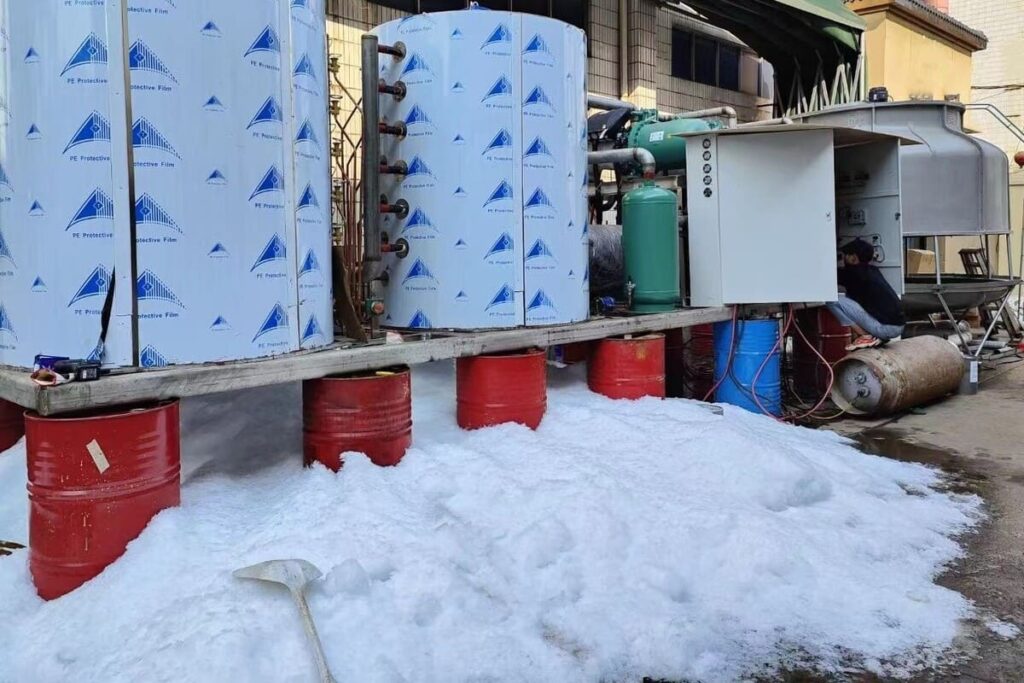Improving water circulation for better flake ice machine performance is crucial in industries such as fishery, seafood distribution, chilled and frozen meat import/export, and food processing plants. Proper water circulation ensures that these ice machines operate efficiently while maintaining the quality of the ice produced.
In this blog post, we will delve into the importance of water circulation in flake ice machines and discuss common signs of poor water circulation. You will learn how to maximize water circulation for optimal flake ice machine performance by improving water flow through the machine and increasing airflow around it.

We will also cover strategies to optimize water temperature for maximum efficiency and provide guidance on maintaining the cleanliness of your flake ice machine components. By implementing these best practices, you can enhance your equipment’s performance while reducing downtime due to maintenance issues or inadequate ice production.
Understanding Flake Ice Machines
Flake ice machines are a must-have for various industries. These machines produce small flakes of ice that can be easily molded around products to maintain their freshness and quality.
Basic Explanation of How Flake Ice Machines Work
In a typical flake ice machine, water flows over an evaporator plate or drum where it freezes into thin layers. A scraper blade then removes the frozen layers from the surface, creating small flakes that fall into an insulated storage bin below.
The Role of Water Circulation in Flake Ice Machine Functioning
- Efficient freezing: Proper water flow over the evaporator plate ensures uniform freezing temperatures across its entire surface area.
- Ideal thickness: Adequate water circulation helps control the thickness of each layer before being scraped off as flakes.
- Faster production: Optimal flow rates increase overall efficiency by reducing freeze times between cycles.
Common Problems Faced by Flake Ice Machines Due to Inadequate Water Circulation
- Poor quality: Insufficient or uneven flow may cause irregularly shaped or overly thick flakes that do not provide the desired cooling effect.
- Reduced output: Inadequate water circulation can slow down ice production, leading to decreased machine capacity and longer wait times for users.
- Inefficient operation: Poor water flow may cause the evaporator plate to freeze completely, forcing the machine into a defrost cycle and wasting energy in the process.
Importance of Water Circulation in Flake Ice Machines
Proper water circulation is crucial for the efficient and optimal performance of flake ice machines. Understanding the correlation between water circulation and ice production can help you maintain your machine for maximum productivity.
Correlation Between Water Circulation and Ice Production
Efficient water flow is directly related to the quantity and quality of ice produced by a flake ice machine. Inconsistent water flow can result in reduced output, unevenly sized or poorly formed flakes, and decreased productivity levels.

Impact on Quality of Ice Flakes
The quality of flake ice depends largely on proper water circulation within the machine’s components, such as evaporators and pumps. A consistent flow allows for even freezing temperatures across all surfaces, resulting in uniform flakes with good texture and structure suitable for various applications like fishery, seafood distribution, and chilled meat import/export operations. (source)
Energy Efficiency Benefits
- Reduced energy consumption: Proper water circulation enables efficient heat transfer during the freezing process, reducing overall energy consumption by maintaining optimal operating conditions.
- Faster freeze times: Consistent flows allow for quicker cooling rates inside evaporator plates, shortening freeze cycles and leading to better time management and cost savings over long-term use cases, such as food processing plants.
In summary, ensuring adequate water movement throughout your Hiceay flake ice machine is essential for maintaining high-quality ice production and energy efficiency. By paying attention to water circulation, you can optimize your machine’s performance and prolong its lifespan.
Signs of Poor Water Circulation in Flake Ice Machines
Poor water circulation can lead to a variety of issues that affect ice production and machine efficiency. It’s crucial to identify these signs early on to maintain optimal performance. Here are some potential indicators of poor water circulation:
- Decreased ice production: If your flake ice machine is producing less ice than usual, it could be due to inadequate water flow.
- Inconsistent ice quality: Poor water circulation may result in uneven freezing, leading to inconsistent flake sizes or shapes.
- Noisy operation: A lack of proper water flow can cause the pump or other components within the machine to work harder, resulting in increased noise levels.
- Frequent maintenance issues: Inadequate water circulation may cause various components within the flake ice machine to wear out more quickly or become damaged, necessitating frequent repairs.
The impact of these signs on your business operations cannot be overstated – decreased productivity and increased downtime for repairs translate into higher costs and reduced profits. Timely identification and rectification are crucial for maintaining efficient operation.
Expert Tips for Optimal Performance
To ensure optimal performance from your flake ice machines by Hiceay, reach out to our team for assistance with troubleshooting any issues related to poor water circulation. We’re here to help you keep your equipment running smoothly while maximizing its lifespan.
For further insight into the significance of adequate water circulation in Hiceay flake ice machines, please refer to this article from the National Oceanic and Atmospheric Administration.
Maximize Water Circulation for Optimal Flake Ice Machine Performance
This not only produces high-quality ice flakes but also improves energy efficiency and extends the life span of your equipment. Here are some expert tips from Hiceay on how to optimize water circulation:
- Maintain proper water level: Keep the water level in the reservoir at the recommended point to prevent air from entering the pump and causing cavitation. This can lead to reduced flow rates and increased wear on components.
- Clean or replace filters regularly: Dirty or clogged filters can obstruct water flow through your flake ice machine, leading to poor performance and potential damage over time. Follow the manufacturer’s guidelines to clean or replace filters regularly for optimum results.
- Avoid kinks in hoses: Check all hoses connected to your flake ice machine for any kinks or bends that may restrict water flow. Straighten out any problem areas to ensure the smooth passage of liquid throughout the system.
- Incorporate a bypass valve: Installing a bypass valve allows you to control excess pressure within your flake ice machine while maintaining consistent flow rates across all components during operation. This ensures efficient use of energy resources without compromising overall performance (source).
By following these steps, you can maximize water circulation within your Hiceay flake ice machine, resulting in better performance and a longer life span for your equipment. Don’t let poor water circulation ruin your ice-making equipment.
Improve Water Flow Through Your Flake Ice Machine
Want to make sure your Hiceay flake ice machine is performing at its best? Start by improving the water flow. Here are some tips:
Maintain Proper Water Pressure
Make sure the incoming water supply has enough pressure to support the efficient operation of the flake ice machine. Check your Hiceay user manual for specific recommendations on ideal water pressure.
Clean or Replace Filters Regularly
Clogged or dirty filters can restrict water flow, leading to reduced performance and potential damage to components over time. Refer to your Hiceay user manual for guidelines on cleaning or replacing filters.
Avoid Kinks in Hoses
Kinked hoses may impede smooth water flow, causing inadequate circulation within the system. Inspect all hoses connected to your flake ice machine periodically and straighten any kinks if needed.
Increase Pipe Diameter (If Necessary)
If low water flow persists despite following other measures, consider increasing pipe diameter according to professional advice from a certified technician or by contacting Hiceay Support Team.
By following these steps, you’ll not only enhance overall efficiency but also extend the lifespan of your Hiceay flake ice machine while maintaining high-quality ice production. Maintaining your Hiceay flake ice machine is essential for achieving peak performance and effectiveness.
Increase Airflow Around the Flake Ice Machine
Proper airflow is essential for the optimal performance and efficiency of your flake ice machine. It helps maintain the right temperature, prevents overheating, and ensures smooth operation. Here are some effective ways to increase airflow around your flake ice machine:
A. Ensure Adequate Space Around the Machine
To improve airflow, make sure there is enough space around your flake ice machine. Maintain a minimum clearance of 12 inches on all sides to allow air circulation without obstruction.
B. Clean Condenser Coils Regularly
Cleaning condenser coils regularly ensures they function efficiently and maintain proper airflow within the system. Dirty or clogged coils can restrict air movement, leading to poor cooling performance and increased energy consumption.
C. Use Proper Ventilation Systems
If your flake ice machine is installed indoors, it’s crucial to have a well-designed ventilation system in place that effectively removes heat generated by the equipment while allowing fresh air intake for efficient cooling. Consider using:
- Ducted Exhaust System: This type of ventilation system uses ducts to remove hot air from around the unit and expel it outside.
- Air Curtains: These devices create an invisible barrier between two areas using high-speed fans that help separate cold indoor air from warm outdoor air, thus maintaining optimal temperatures inside while reducing energy costs associated with heating or cooling systems. Learn more about air curtains here.
- Fans & Blowers: Strategically placed fans or blowers can significantly improve overall airflow by circulating cool ambient air throughout the space where flake ice machines are installed.
By following these simple steps, you can effectively increase airflow around your flake ice machine and enjoy better performance, efficiency, and a longer lifespan for your equipment. So, keep it cool and breezy.
To improve the performance and efficiency of your flake ice machine, it’s important to increase airflow around the unit. This can be achieved by ensuring adequate space around the machine, cleaning condenser coils regularly, and using proper ventilation systems such as ducted exhaust systems or air curtains. By following these simple steps, you can maintain optimal temperatures inside while reducing energy costs associated with heating or cooling systems.
Optimize Water Temperature for Maximum Efficiency
Don’t let your flake ice machine be a hot mess. Optimizing water temperature is key to improving performance and efficiency. The ideal water temperature determines the quality of ice flakes and reduces energy consumption.

Achieving Ideal Water Temperature
For the best quality ice and energy savings, keep the water temperature between 50°F (10°C) and 60°F (15°C). Check Hiceay for specific recommendations. This will help you produce high-quality ice while minimizing energy usage.
Monitor Incoming Water Supply
Regularly monitor your incoming water supply to identify fluctuations that may affect your flake ice machine’s performance. Install a thermostat or digital thermometer on the main water line for accurate readings and alerts if adjustments are needed.
Maintain Proper Insulation
- Pipes: Insulate all pipes carrying chilled or heated water to prevent heat loss or gain during transit to the flake ice machine.
- Tank: Check that your storage tank has adequate insulation to maintain consistent temperatures throughout operation hours.
Tips for Adjusting Water Temperature
- Install an inline heater or chiller system designed for commercial applications like those offered by Hiceay. This allows precise control over incoming water temperatures without affecting other areas of your facility.
- Use a heat exchanger to recover waste heat from other processes in your plant. This can preheat or cool the water supply for your flake ice machine, optimizing temperature and increasing overall energy efficiency.
By optimizing water temperature and following these best practices, you’ll ensure maximum efficiency and improved performance of your flake ice machine. Don’t let your ice melt away – keep it cool and fresh.
Maintain Cleanliness of Flake Ice Machine Components
Keeping your flake ice machine components clean is crucial for optimal performance and a longer lifespan. Regular cleaning ensures proper water circulation and prevents potential issues caused by mineral buildup, algae growth, or other contaminants.
To keep your flake ice machine running efficiently, follow these simple maintenance tips:
- Keep it clean: Regularly inspect and clean the water inlet valve, distribution tubes, and spray nozzles to prevent clogging. Use a soft brush or cloth to remove any debris or mineral deposits.
- Descale the evaporator: Over time, mineral buildup can affect heat transfer efficiency and reduce overall performance. Follow manufacturer guidelines for descaling procedures using approved chemicals.
- Use biocides: Algae growth can cause blockages in pipes and negatively impact ice quality. Treat circulating water with an appropriate biocide according to manufacturer recommendations to inhibit microbial growth.
- Install filtration systems: Sediment filters on incoming water lines help remove suspended particles that could potentially damage internal components or contaminate ice flakes.
- Schedule regular inspections: Have a qualified technician inspect your flake ice machine periodically for signs of wear or damage that may require repair or replacement parts.
A well-maintained flake ice machine will provide consistent high-quality flakes while reducing energy consumption costs associated with poor performance due to inadequate water circulation. By following these guidelines, you can maintain your flake ice machine’s peak performance for years to come.
FAQs about How to Improve Water Circulation for Better Flake Ice Machine Performance
How to Boost Your Ice Machine’s Efficiency
Ensure proper water circulation, maintain the cleanliness of components, optimize water temperature, and increase airflow around the unit to make your ice machine more efficient. Regular maintenance is also crucial for optimal performance. (source)
Why Your Ice Makers Isn’t Getting Enough Water
Clogged filters or supply lines, low water pressure, or a malfunctioning inlet valve could be the reason why your ice makers aren’t getting enough water. Check these components and replace them if necessary. (source)
Why Your Ice Maker is Slow in Making Ice
Poor water circulation, high ambient temperatures affecting the condenser’s efficiency, or dirty evaporator plates could be the reason why your ice maker is slow in making ice. Ensure regular cleaning and maintenance to improve its performance. (source)
What’s the Ideal Water Temperature for an Ice Machine?
The ideal incoming water temperature for an ice machine ranges between 45°F (7°C) and 90°F (32°C). However, most manufacturers recommend a temperature of 50°F (10°C) to achieve maximum efficiency without compromising equipment lifespan. Consult your machine’s user manual for specific recommendations. (source)
Conclusion
Optimizing water circulation is key for top-notch flake ice machine performance, preventing damage and inefficiency.
Signs of poor water circulation can lead to reduced efficiency and potential damage to components.
Maximizing water circulation involves improving water flow, increasing airflow, optimizing water temperature, and maintaining component cleanliness.
By following these steps, businesses in the food industry can ensure their flake ice machines produce high-quality ice for their needs.


